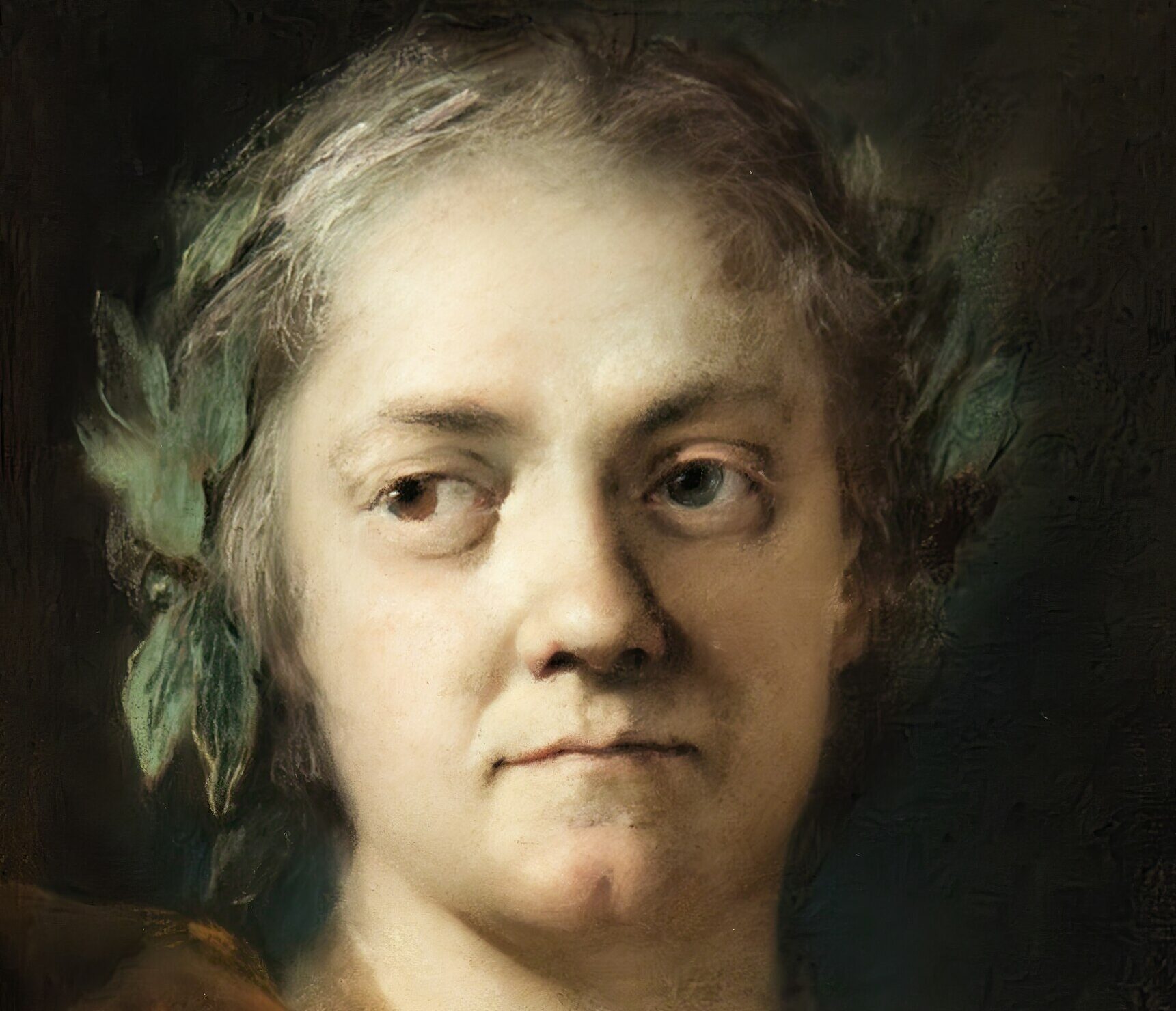Why do so few people know the names and works of Artemisia Gentileschi or Rosalba Carriera? Art history has poorly and inadequately documented the work of these two talented artists, who nonetheless played an important role in Italian culture and society. As it neglected them, it often reduced other women to mere muses or models, denying them recognition in painting or sculpture and overlooking their skills, creativity, expressive space, and access to workshops or academies. In the age-old struggle against gender disparity and discrimination, art (as a collective heritage) has lost a great deal.
Rosalba Carriera, who lived between 1673 and 1757, was the most famous Italian artist in eighteenth-century Europe. From English lords to Austrian princes, the nobility of the old continent lined up outside her studio, eager to have a pastel portrait or a fine miniature on ivory. Just being able to pose for her, and later boast about that era’s “photograph,” was a status symbol, a mark of social, financial, and elitist recognition. This says a lot about the value that art once held in society, a value it has lost today.
For nearly half a century, the courts of Europe sought her services. Despite frequent invitations and generous proposals, except for three stays at the courts of the King of France, the Duke of Modena, and the Emperor in Vienna, Carriera preferred to remain in Venice, where she worked tirelessly all her life, not only as a pioneering artist but also as a true entrepreneur.
Before her, the Roman Artemisia Gentileschi (1593-1656) is today more known for the violence she suffered and the courage with which she faced the subsequent trial rather than for the refinement of her creative work. Her innate talent for the fine arts emerged early and was refined first by the innovations of her contemporary Caravaggio, from whom she learned to use real models and the ability to transfigure them to express powerful yet realistic drama, and later by the teachings of the great masters who worked in Venice, like Tintoretto and Veronese.
In addition to creating the finest portraits of Venetian and European high society in the eighteenth century, capturing the ideals of grace and elegance of an entire era, Rosalba Carriera also pioneered a new genre: miniature painting on ivory. Through an innovative technique, Carriera brought the loose and vibrant brushstrokes of canvas painting to the tiny surface of ivory discs for the first time: the success was immediate. No traveler during their stay in Venice would miss the opportunity to own one of her ivory miniatures.
Artemisia Gentileschi’s work “Judith Slaying Holofernes” speaks for her: the painting shows the dramatic talent, vivid colors, and powerful emotions that define her art. Moreover, with Gentileschi, the women she portrayed were always the protagonists, a true innovation for her time. It is also notable that she was the first woman admitted to the prestigious Accademia del Disegno in Florence.
The fundamental issue is that the role of women in art has always conflicted with the roles assigned to them by a patriarchal society. This same impediment still hinders women today from pursuing degrees in science, technology, engineering, and mathematics (STEM). Until half a century ago, graduating in fields like physics, medicine, or engineering was a significant social challenge for women. It’s astonishing to think that the first woman to graduate (in philosophy) was Elena Lucrezia in 1678, or that it took until 1877 to have the first female doctor, Ernestina Paper, and until 1908 for the first woman to graduate in civil engineering in Italy, Emma Strada. Amalia Ercoli Finzi, the first female aeronautical engineer, who graduated in 1961, became one of the world’s leading figures in aerospace science and technology (serving as a scientific advisor to NASA, ASI, and ESA, and as the “Principal Investigator” of a tool on the Rosetta space probe). This underscores how much society has lost by blocking or hindering women’s access to education.
For a girl, the rank of intellectual or artist was as inappropriate yesterday as it is today. Every statistic on the gender gap confirms this. In art, women remain in the background, less celebrated than their male counterparts. Tina Modotti, for instance, is one of the greatest photographers of the 20th century, with her works housed in the most prestigious institutions and museums worldwide, including the International Museum of Photography and Film at George Eastman House in Rochester and the Library of Congress in the United States. In June 1913, she sailed to San Francisco, before settling in Los Angeles and later Mexico. Through her, photography became a tool for social investigation and activism. Yet, her name shines much less brightly than the more famous Gianni Berengo Gardin or Luigi Ghirri.
Perché in pochissimi conoscono il nome e le opere di Artemisia Gentileschi o di Rosalba Carriera? La storia dell’arte ha raccontato poco e male il lavoro di queste due talentuose artiste che tuttavia hanno avuto un ruolo importante nella cultura e nella società italiana. Ma come ha trascurato loro, così ha spesso ridotto a semplici muse o modelle l’altra metà del cielo, negando alle donne il protagonismo nella pittura o nella scultura e non riconoscendone nemmeno abilità, creatività, spazio espressivo ma anche accesso a botteghe o accademie. Nella lotta atavica alla disparità e alla differenza di genere, anche l’arte (come patrimonio collettivo) ha perso molto.
Rosalba Carriera, che visse tra il 1673 e il 1757, è stata l’artista italiana più celebre nell’Europa del Settecento. Dai lord inglesi ai principi austriaci, la nobiltà del vecchio continente faceva la fila davanti al suo studio, aspirava ad avere un suo ritratto a pastello o una sua pregevole miniatura su avorio. Solo riuscire a posare per lei, per poi vantare quella “fotografia” dell’epoca, equivaleva ad uno status symbol, ad avere un riconoscimento sociale, finanziario, elitario. Cosa che la dice lunga sul valore che l’arte aveva, e che oggi ha perso, nella società. Per quasi mezzo secolo, le corti d’Europa cercarono di accaparrarsi i suoi servigi, eppure, nonostante i frequenti inviti e le generose proposte, salvo tre soggiorni alla corte del re di Francia, del duca di Modena e a quella dell’imperatore a Vienna, Carriera preferì rimanere a Venezia, dove lavorò incessantemente per tutta la vita ma come una vera imprenditrice e non solo come un’artista antesignana.
Prima di lei la romana Artemisia Gentileschi (1593-1656), oggi più nota per la violenza subita e il coraggio con cui affrontò il successivo processo, che non per la raffinatezza della sua opera creativa. Il talento innato per le belle arti emerse subito e si perfezionò risentendo prima delle innovazioni del contemporaneo Caravaggio, dal quale imparò l’uso di modelli reali e la capacità di trasfigurarli per esprimere una potente quanto realistica drammaticità, e poi degli insegnamenti dei grandi maestri che operarono in laguna come il Tintoretto e il Veronese.
A Carriera, oltre alla migliore ritrattistica dei personaggi della società veneziana ed europea del Settecento, di cui interpretò in modo impareggiabile gli ideali di grazia e di eleganza di un’intera epoca, quella “vita felice” poi entrata nell’immaginario collettivo e con cui identifichiamo l’Ancien Régime, va attribuito anche un genere nuovo: la pittura di miniature su avorio. Attraverso una tecnica innovativa Carriera riuscì a portare, per la prima volta, sulla minuscola superficie dei fondini d’avorio, la pennellata sciolta e vibrante della pittura su tela. Il successo fu immediato. Non ci fu viaggiatore che durante il suo soggiorno veneziano non ambisse ad avere il proprio avorio miniato.
Per Gentileschi parla “Giuditta che decapita Oloferne”. La tela sprigiona il suo talento drammatico, il colore vivo e le emozioni che segnano la sua arte. Non solo. Con lei la donna ritratta è sempre protagonista e fu una vera innovazione per il suo tempo, senza dimenticare che lei fu la prima donna ad essere ammessa alla prestigiosa Accademia del disegno di Firenze.
Il problema di base è che il ruolo femminile nell’arte si è sempre scontrato con il ruolo secolare attribuito da una società patriarcale alla donna. Lo stesso impedimento che oggi frena ancora, ad esempio, le lauree scientifiche o lo studio delle Stem (scienze, tecnologie, ingegneria e matematica). Fino a mezzo secolo fa, anche laurearsi in fisica, medicina o ingegneria era una sfida sociale. E’ incredibile pensare che la prima laureata donna (in filosofia) è stata Elena Lucrezia nel 1678 o che bisognerà attendere il 1877 per avere la prima medico donna, Ernestina Paper, o il 1908 per la prima laureata in ingegneria civile in Italia con Emma Strada. Se pensiamo che Amalia Ercoli Finzi, prima ingegnera aeronautica nel 1961, è diventata una delle personalità più importanti al mondo nel campo delle scienze e tecnologie aerospaziali (è consulente scientifica della Nasa, di Asi ed Esa, nonché Principal Investigator di uno strumento della sonda spaziale Rosetta), capiamo agevolmente quanto “tutti” abbiamo perso, bloccando o ostacolando l’accesso delle donne agli studi.
Ad una ragazza, il rango di intellettuale o di artista non si addiceva ieri come oggi. Ogni statistica sul gender gap lo conferma. Anche nell’arte le donne restano in seconda fila, più defilate rispetto alla fama raggiunta dai colleghi uomini. Tina Modotti, ad esempio, è una delle più grandi fotografe del XX secolo, tanto che le sue opere sono conservate nei più importanti istituti e musei del mondo, fra i quali l’International Museum of Photography and Film at George Eastman House di Rochester o la Library of Congress degli Stati Uniti. Nel giugno del 1913 salpò per San Francisco, prima di stabilirsi a Los Angeles e poi in Messico. Con lei la fotografia diventò strumento di indagine e denuncia sociale. Eppure, il suo nome brilla molto meno dei più famosi Gianni Berengo Gardin o Luigi Ghirri.





























